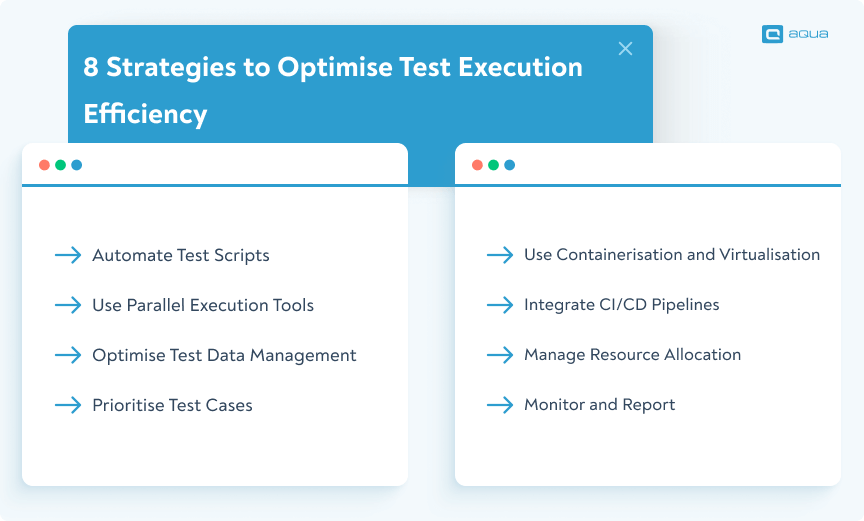Strategies to Optimise Test Execution Efficiency Across Multiple Environments
To achieve optimal efficiency in test execution across various environments, you must implement strategic measures that maximise resource utilisation. Here are key strategies to enhance your testing practices:
1. Automate Test Scripts:
- Develop automated test scripts to replace manual testing, ensuring faster and more consistent execution.
- Use frameworks like Selenium, Appium, or Cypress to automate tests across different browsers and devices.
2. Use Parallel Execution Tools:
- Implement tools and platforms that support parallel testing, such as Jenkins, Selenium Grid, or cloud-based testing tools like aqua (we’ll talk about this in detail later).
- Configure these test automation management tools to run multiple tests simultaneously across various environments.
3. Optimise Test Data Management:
- Use synthetic data generation and data masking to create consistent and reusable test data.
- Implement centralised test data management solutions to ensure data consistency across different test environments.
4. Prioritise Test Cases:
- Focus on executing the most critical and high-impact test cases first.
- Use risk-based testing to prioritise test cases that cover the most important functionalities and potential failure points.
5. Use Containerisation and Virtualisation:
- Use containerisation technologies like Docker to create lightweight and isolated test environments quickly.
- Use virtual machines and cloud-based environments to replicate different test scenarios and configurations efficiently.
6. Integrate CI/CD Pipelines:
- Integrate your testing processes into CI/CD pipelines to ensure automated and continuous testing with every code change.
- Use tools like Jenkins, GitLab CI, or CircleCI to automate the deployment of test environments and the execution of test suites.
7. Manage Resource Allocation:
- Monitor and manage the allocation of computational resources to ensure optimal performance and avoid bottlenecks.
- Use resource management tools to dynamically allocate resources based on test execution needs and priorities.
8. Monitor and Report:
- Employ monitoring tools to track the performance and status of test executions in real-time.
- Use advanced reporting tools to analyse test results and identify areas for improvement.

These strategies require initial setup and ongoing maintenance, but they significantly enhance the efficiency and reliability of your testing processes. To help you navigate parallel testing challenges effectively, we will introduce you to the ultimate solution in this article. Just stay tuned.
How does parallel testing ensure comprehensive coverage across environments?
Parallel testing ensures comprehensive coverage across environments by allowing you to run multiple test cases simultaneously on different platforms, configurations, and devices. This approach offers several key advantages:
- Testing Efficiency: With parallel test execution, you can significantly reduce the time required to complete test cycles. This efficiency allows for more extensive testing within the same timeframe, ensuring that all necessary scenarios are covered across various environments.
- Consistent Validation: Parallel test execution in testing enables the simultaneous validation of software functionalities across different environments. This consistency ensures that the application behaves as expected under various conditions, identifying environment-specific issues that might otherwise go unnoticed.
- Resource Optimisation: Utilising multiple environments concurrently maximises resource utilisation, ensuring that hardware and software resources are effectively leveraged. This optimisation not only speeds up the testing process but also allows for more comprehensive testing by covering more ground in less time.
- Early Defects Detection: Running tests in parallel helps you detect defects and discrepancies early in the development cycle. This early detection allows for timely resolution, reducing the risk of critical issues persisting into later stages of development or production.
By using parallel testing, you can ensure that your software is rigorously tested across all relevant environments. How? We explain in the next sections.
How to perform parallel testing with aqua cloud tool
First off, let’s introduce aqua cloud to you, as our practical guide will be explained using it. aqua cloud is a Test Management System (TMS) that uses the power of AI (the first one to do so in QA) to streamline various software testing efforts, including cross-browser testing, test case management and organisation. Trusted by numerous companies across Europe US, Canada Australia, and Asia, aqua cloud simplifies complex testing processes, making it an inevitable tool to choose for efficient parallel testing across multiple environments. aqua also supports native integration with:
- Shell environments like PowerShell and UnixShell;
- Automated testing tools like Ranorex and UFT;
- CI/CD tools like Jenkins;
- Load testing tools like JMeter;
- Database testing tools like MSSQL and Oracle (including MySQL);
- API testing tools like SoapUI;
- Custom integrations with REST API.
Main challenges in parallel testing:
- Data Setup: Avoid conflicts when tests modify the same record.
- State Management: Ensure application state remains consistent.
- UI Tests: Don't share the same WebDriver instance.
- Reporting: Merge test results into one unified report.
- Hardware Requirements: Consider the number of vCPUs available.
- Parallelisation Methods: Choose between parallel tests per file or managing custom threads, each with its stability issues.
What challenges does aqua cloud solve?
When testing a web or desktop application, you will inevitably need to execute your test cases in different environments that your application must support. For web applications, this could mean testing across different browsers or various versions of the same browser. For desktop applications, it might involve different operating systems (Windows, macOS, Linux) or different versions of the same OS (e.g., Windows 10 and Windows 11). These scenarios introduce significant complexity to your testing efforts:
- Managing Diversity: Effectively and conveniently managing the diversity of versions, environments, test cases, and test runs can be challenging and time-consuming.
- Extended Testing Cycles: More environments mean longer testing cycles as you need to run all or a portion of your tests in each environment. Therefore, the issue of parallel testing across different environments becomes highly relevant.
How aqua cloud simplifies parallel testing in various environments
So here it is: this section will demonstrate how aqua cloud specifically addresses these challenges and simplifies this stage of testing. Despite the complexity, a professional TMS like aqua can help you achieve seamless parallel testing effortlessly. Here’s how, before we show it in our video guide:
Step-by-Step Guide to Parallel Testing with aqua cloud
Step 1: Identify the List of Environments
Determine the environments where you need to perform testing. For instance, if you are testing a desktop application (like “Calculator”, in our simple example) on Windows 10 and Windows 11, list these environments accordingly.
Step 2: Configure Agents for Each Environment
Set up an agent for each environment. For launching applications in Windows 10 directly from aqua, use a PowerShell agent for integration. Make simple adjustments to each agent to bind them to your aqua instance and specific project, then launch each agent in each environment.
Note: This preparation step is similar for other agents, such as a UnixShell agent for desktop applications or a Ranorex/Selenium agent for web applications, etc.
Step 3: Prepare Your Test Set
Select the test case or set of test cases that need to be executed in these environments and add them to a separate test scenario. Ensure your test data is ready and properly configured.
Step 4: Link Test Executions to Your Agents
Create a separate test execution for each test case in each environment and link it to the previously configured agents.
Step 5: Run Your Test Scenario
With everything set up, aqua allows you to run the tests sequentially or in parallel. If your test plan supports parallel execution, initiate the tests in parallel to save time and increase efficiency.
Step 6: Track Your Results
Navigate to the “Executions” section to collect the results of the entire test scenario. aqua cloud provides detailed insights into each test case, test steps, execution logs, and overall outcomes.
And here is the video explanation of what you’ll do (make sure you watch it till the end for full understanding):
By following these steps, aqua cloud streamlines the whole parallel testing efforts for you. It not only simplifies complex testing scenarios but also enhances your overall testing strategy, making it an invaluable asset for your software development lifecycle. Apart from this parallel testing mastery, aqua’s AI-powered features also allow you to generate test cases from requirements in a few seconds. With aqua, you have a central repository where you can manage all your testing efforts efficiently, and benefit from an all-around AI copilot to turn your QA work into a breeze. Its integration with Capture will be the cherry on top: it will level up your defect tracking game with 1-click bug reports and 100% visual clarity. Taking away the pain of testing is not a dream, it’s an opportunity a few clicks away from you. So what are you waiting for?
Save at least 50% of your time in parallel test execution with aqua
Conclusion
Executing parallel testing across multiple environments is challenging due to the complexities of managing diverse configurations and extended testing cycles. However, aqua cloud effectively addresses these issues, simplifying the process and enhancing efficiency. By choosing aqua, you benefit from efficient parallel execution that reduces overall testing time, seamless environment management that ensures consistent test execution across multiple environments, and comprehensive test coverage through extensive parallel test scenarios. With aqua cloud, you can achieve thorough validation across different platforms and deliver high-quality software more efficiently.


















